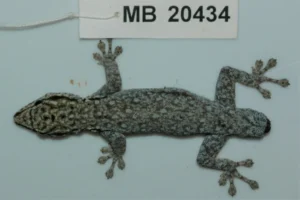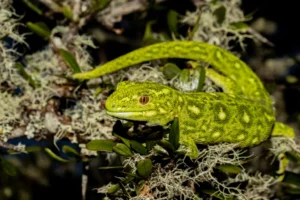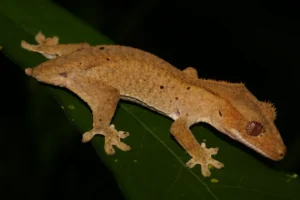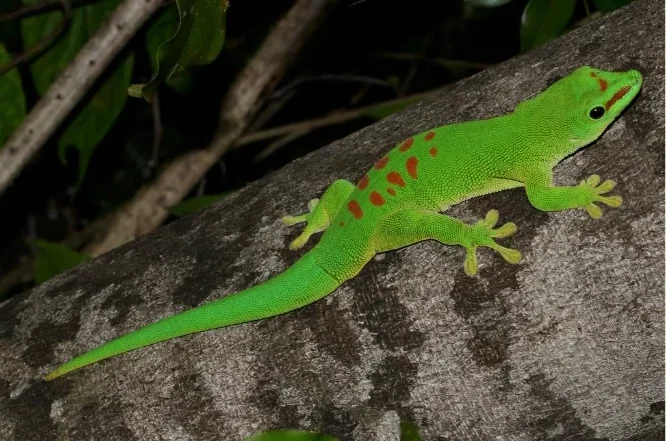If you’ve ever seen a lizard dash across your yard or up a wall, you might have noticed something weird: its tail sometimes just… disappears. One second it’s there, wagging or coiling behind the little guy, and the next, it’s gone. This isn’t magic.
It’s a clever trick called tail autotomy, and it’s one of the most interesting things lizards can do. But once a lizard drops its tail, the big question is: how long does it take to grow it back?
The time it takes a lizard to regrow its tail varies a lot depending on the species, the lizard’s age, health, and environment. On average, a lizard can start growing a new tail within a few days, but the full regrowth can take anywhere from a few weeks to several months.
The new tail isn’t exactly like the old one. It can look a bit different in shape, color, and texture.
Knowing how long it takes and what affects it can be really helpful, especially if you have a pet lizard or are just curious about how nature works.
Why Lizards Drop Their Tails
Before we talk about regrowth, let’s think about why a lizard drops its tail at all. Tail dropping isn’t an accident or a sign of weakness. It’s a defense trick that lizards have had for millions of years.
If a predator grabs a lizard by the tail, the tail can break off at special points along the bones. This lets the lizard keep moving while the predator gets distracted.

The tail left behind often keeps wiggling for several minutes, which is just enough to confuse the predator. You could think of it as a little wiggly decoy. It’s a simple trick, but it works really well.
Not all lizards can drop their tails. Many geckos, anoles, and skinks do it regularly. Chameleons and iguanas usually can’t, so they run fast, hide, or use their claws instead.
How a Tail Grows Back
Once the tail is gone, the lizard doesn’t just sit there. Its body immediately starts the regrowth process. First, the wound heals. The lizard seals off the area to stop blood loss and infection. Then a structure called a blastema forms at the base of the tail.
Think of the blastema like a little growth hub. It has special cells that multiply and turn into muscle, skin, cartilage, and sometimes even bone.
That’s how the lizard grows a new tail almost from scratch.
At first, the new tail is small and stubby, often pale or a little see-through. Over the weeks, it gets longer and thicker and starts looking more like a normal tail. But there are some differences:
-
The new tail usually has cartilage instead of bone, so it’s a bit softer.
-
The color can be different, sometimes lighter or darker.
-
The scales may be arranged differently, so the tail can feel smoother or rougher.
How Long Does It Take?
Here’s the part most people want to know. There’s no single answer because it depends on a few things.
Small lizards like anoles or house geckos might show tail growth in a week or two. Full regrowth can take four to six weeks. Medium lizards, like leopard geckos or skinks, might take two to three months.

Big species, like monitors or iguanas, can take six months or even longer.
Here’s a quick look at some common lizards and how long it usually takes:
| Lizard Species | Can They Drop Their Tail? | Tail Regrowth Time | Notes |
|---|---|---|---|
| Green Anole | Yes | 4–6 weeks | Tail drops easily; new tail often shorter |
| Brown Anole | Yes | 4–6 weeks | Common in gardens; tail wiggling distracts predators |
| Leopard Gecko | Yes | 8–12 weeks | Pet lizard; tail may change shape or color |
| Blue-Tongued Skink | Yes | 3–5 months | Thick tail; slower but works fine |
| Common House Gecko | Yes | 6–8 weeks | Tail grows fast; often pale at first |
| Iguana | Limited | 6–12 months | Very big tail; growth slow and sometimes incomplete |
| Crested Gecko | Yes | 3–6 months | Popular pet; tail rarely fully regrows in adults |
| Tokay Gecko | Yes | 2–3 months | Strong tail; can drop if stressed |
| Five-Lined Skink | Yes | 4–8 weeks | Juveniles lose tail easily; adults less often |
| Eastern Fence Lizard | Yes | 4–6 weeks | Tail used to escape predators; regrows quickly |
| Common Wall Lizard | Yes | 6–10 weeks | Can drop tail multiple times; new tail different texture |
| Sand Lizard | Yes | 8–12 weeks | Tail breaks under attack; regrows thinner |
| Slow Worm | Yes | 2–4 months | Legless lizard; tail shedding common for defense |
| Glass Lizard | Yes | 3–6 months | Another legless lizard; tail breaks easily |
| Collared Lizard | Yes | 4–6 weeks | Uses tail drop to escape; regrowth fast |
| Bearded Dragon | Limited | 4–6 months | Rarely drops tail; mostly when severely stressed |
| Madagascar Ground Gecko | Yes | 2–3 months | Small tail; drops easily; often eaten by predator |
| Sandfish Skink | Yes | 2–3 months | Desert species; uses tail to distract predators |
| Monitor Lizard | No | N/A | Cannot drop tail; relies on strength and speed |
| Gila Monster | No | N/A | Venomous; tail not autotomized; stores fat instead |
Smaller lizards usually grow tails faster. Younger lizards grow tails faster than older ones because their bodies work faster and their cells divide more quickly.
Health and food also make a big difference. A stressed or malnourished lizard may take longer, or the new tail might be smaller or weaker.
Factors That Affect Tail Growth
A few things can change how fast and how well a lizard grows a tail:
-
Age: Younger lizards grow faster.
-
Species: Some lizards are better at regrowing tails than others.
-
Health and Food: A healthy, well-fed lizard grows tails faster.
-
Stress: Too much stress or constant handling can slow growth.
-
Environment: Temperature and humidity matter. Warm, stable spots help tails grow faster.
Even in perfect conditions, the new tail usually isn’t exactly like the old one. It’s good enough to keep the lizard safe.
Does the New Tail Work Like the Old One?
Mostly yes, but not perfectly. Regrown tails can distract predators, help with balance, and store fat, but they might not be as strong or flexible as the original.
For example, a leopard gecko’s new tail is often shorter and chunkier, with duller colors.

Small lizards like anoles may have a stiffer new tail, but it still lets them run, climb, and escape danger.
Losing a Tail More Than Once
Some lizards can drop their tail more than once. If it happens again, the tail starts growing back just like before. But repeated loss can have effects:
-
Each new tail may be smaller or weaker.
-
Growing a tail takes energy away from other things like growing or reproducing.
-
Frequent tail loss can make a lizard more vulnerable.
In the wild, repeated tail loss usually means predators are around. For pets, it could mean stress, rough handling, or a cage that isn’t right.
Pets vs. Wild Lizards
Tail regrowth works the same in pets and wild lizards, but the environment makes a difference. Pet lizards often have steady food and safe spaces, so tails grow faster.
Poor care (like bad food, rough handling, or a dry, cold cage) can slow growth or cause problems.
Sometimes the tail starts growing and then stops if the lizard doesn’t get enough food or warmth.
Wild lizards face more risks like injuries, infections, and limited food, which can slow the process. But they’ve adapted to deal with these problems over millions of years.
Helping a Pet Lizard Grow Its Tail
If your pet lizard loses its tail, you can help it grow a new one:
-
Give a balanced diet with protein, calcium, and vitamins.
-
Keep the cage clean to avoid infection.
-
Keep temperature and humidity right for the species.
-
Handle the lizard gently and only when needed.
-
Don’t try to “fix” the tail yourself. Tails are delicate while growing, and injuries can cause problems. Patience is very important.
What if the Tail Doesn’t Fully Grow?
Sometimes a tail doesn’t fully grow or stops partway. This can happen because of infection, poor food, stress, or age. The lizard will still survive, but the tail might be shorter, uneven, or less useful.

Even a partly grown tail works. It still distracts predators and helps the lizard balance.
FAQs About Lizard Tail Growth
How long does it take for lizards to regrow their tails?
It depends on the species, age, and health of the lizard. Small lizards like anoles can regrow tails in 2–3 months, while larger lizards like leopard geckos may take 6–12 months.
Will the new tail look exactly like the old one?
Usually not. The regenerated tail may be shorter, differently colored, or made of cartilage instead of bone, but it still serves many of the same functions.
Can lizards regrow tails multiple times?
Yes, some lizards can regrow their tails more than once. Each regeneration may produce a tail that looks slightly different from the previous one.
Does losing a tail hurt a lizard?
Lizards don’t feel pain in the tail itself when it drops because the tail has fracture planes and specialized nerves that minimize pain. However, losing a tail is stressful and energetically costly.
How can I help my pet lizard regrow its tail faster?
Keep it healthy and stress-free, provide a proper diet, maintain the right temperature and humidity, and avoid handling it too much while it’s healing.
Conclusion
So, how long does it take for a lizard to grow back its tail? There’s no single answer. Most small and medium lizards will grow a tail in a few weeks to a few months.
Bigger ones can take six months or more. Age, health, diet, stress, and environment all affect how fast and how well it grows.
Even if the new tail looks a bit different, it still works. It helps the lizard move, balance, and stay safe. Watching a tail grow back shows just how tough and interesting these little reptiles are.
If you’ve ever seen a lizard with a stubby or oddly colored tail, now you know, it’s not broken forever. It’s just growing a brand-new one, doing exactly what nature made it to do.
Hi, my name is Ezra Mushala, i have been interested animals all my life. I am the main author and editor here at snakeinformer.com.

